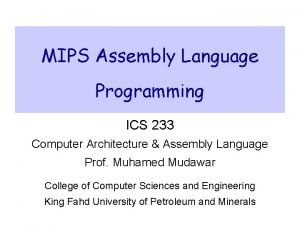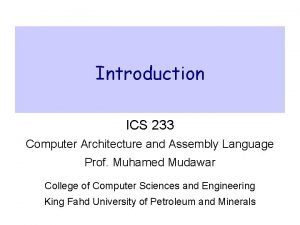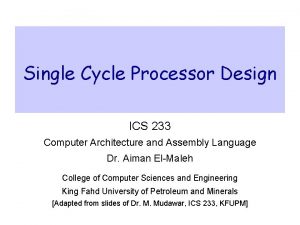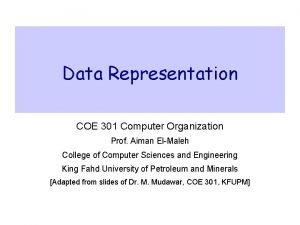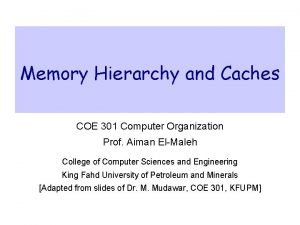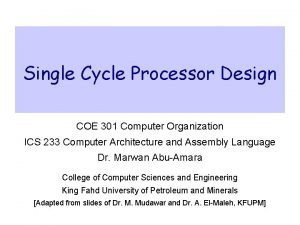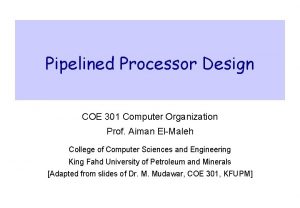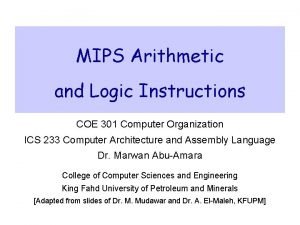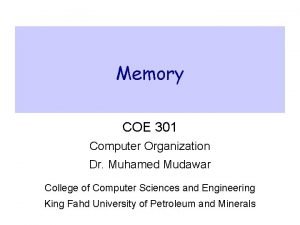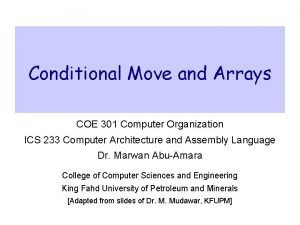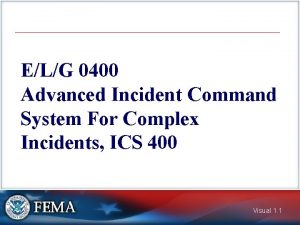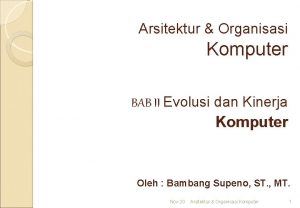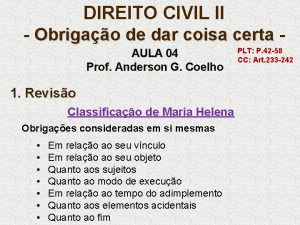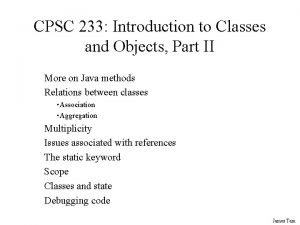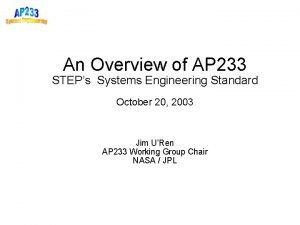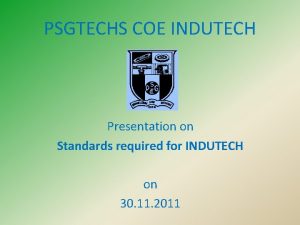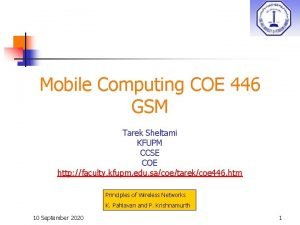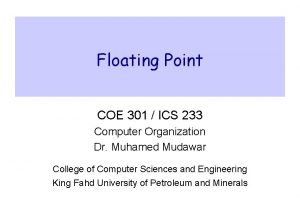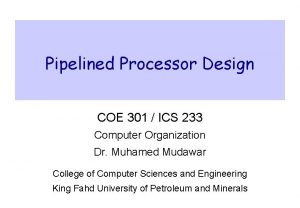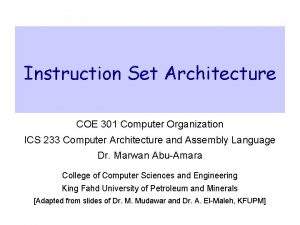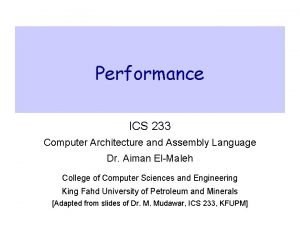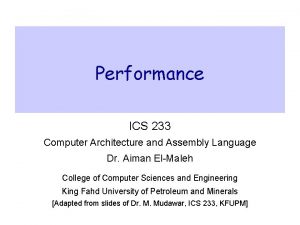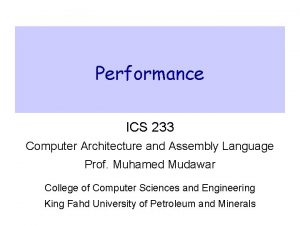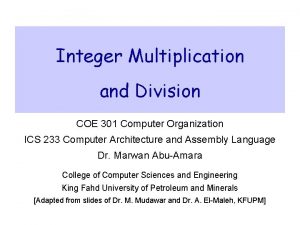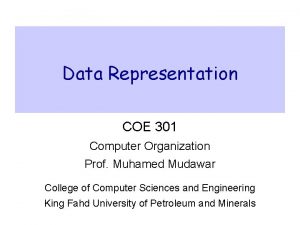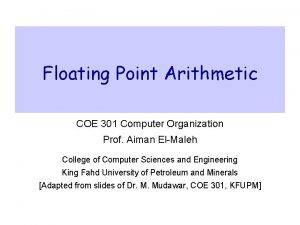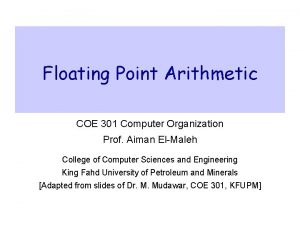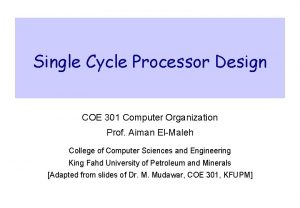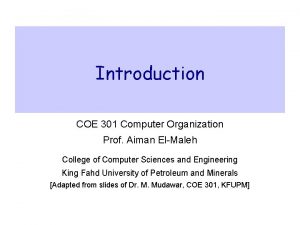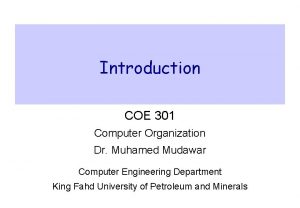Performance COE 301 ICS 233 Computer Organization Dr

































- Slides: 33

Performance COE 301 / ICS 233 Computer Organization Dr. Muhamed Mudawar College of Computer Sciences and Engineering King Fahd University of Petroleum and Minerals

What is Performance? v How can we make intelligent choices about computers? v Why is some computer hardware performs better at some programs, but performs less at other programs? v How do we measure the performance of a computer? v What factors are hardware related? software related? v How does machine’s instruction set affect performance? v Understanding performance is key to understanding underlying organizational motivation Performance COE 301 / ICS 233 – Computer Organization © Muhamed Mudawar – slide 2

Response Time and Throughput v Response Time ² Time between start and completion of a task, as observed by end user ² Response Time = CPU Time + Waiting Time (I/O, OS scheduling, etc. ) v Throughput ² Number of tasks the machine can run in a given period of time v Decreasing execution time improves throughput ² Example: using a faster version of a processor ² Less time to run a task more tasks can be executed v Increasing throughput can also improve response time ² Example: increasing number of processors in a multiprocessor ² More tasks can be executed in parallel ² Execution time of individual sequential tasks is not changed ² But less waiting time in scheduling queue reduces response time Performance COE 301 / ICS 233 – Computer Organization © Muhamed Mudawar – slide 3

Higher Performance = Less Execution Time v For some program running on machine X Performance. X = 1 Execution time. X v X is n times faster than Y Performance. X Performance. Y Performance = Execution time. Y Execution time. X COE 301 / ICS 233 – Computer Organization =n © Muhamed Mudawar – slide 4

What do we mean by Execution Time? v Real Elapsed Time ² Counts everything: § Waiting time, Input/output, disk access, OS scheduling, … etc. ² Useful number, but often not good for comparison purposes v Our Focus: CPU Execution Time ² Time spent while executing the program instructions ² Doesn't count the waiting time for I/O or OS scheduling ² Can be measured in seconds, or ² Can be related to number of CPU clock cycles CPU Execution Time = CPU cycles × Cycle time Performance COE 301 / ICS 233 – Computer Organization = CPU cycles Clock rate © Muhamed Mudawar – slide 5

What is the Clock Cycle? v Operation of digital hardware is governed by a clock Cycle Clock Data transfer & Computation Clock Cycle 1 Clock Cycle 2 Clock Cycle 3 Update state v Clock Cycle = Clock period ² Duration between two consecutive rising edges of the clock signal v Clock rate = Clock frequency = 1 / Clock Cycle ² 1 Hz = 1 cycle/sec 1 KHz = 103 cycles/sec ² 1 MHz = 106 cycles/sec 1 GHz = 109 cycles/sec ² 2 GHz clock has a cycle time = 1/(2× 109) = 0. 5 nanosecond (ns) Performance COE 301 / ICS 233 – Computer Organization © Muhamed Mudawar – slide 6

Improving Performance v To improve performance, we need to ² Reduce the number of clock cycles required by a program, or ² Reduce the clock cycle time (increase the clock rate) v Example: ² A program runs in 10 seconds on computer X with 2 GHz clock ² What is the number of CPU cycles on computer X ? ² We want to design computer Y to run same program in 6 seconds ² But computer Y requires 10% more cycles to execute program ² What is the clock rate for computer Y ? v Solution: ² CPU cycles on computer X = 10 sec × 2 × 109 cycles/s = 20 × 109 cycles ² CPU cycles on computer Y = 1. 1 × 20 × 109 = 22 × 109 cycles ² Clock rate for computer Y = 22 × 109 cycles / 6 sec = 3. 67 GHz Performance COE 301 / ICS 233 – Computer Organization © Muhamed Mudawar – slide 7

Clock Cycles per Instruction (CPI) v Instructions take different number of cycles to execute ² Multiplication takes more time than addition ² Floating point operations take longer than integer ones ² Accessing memory takes more time than accessing registers v CPI is an average number of clock cycles per instruction I 1 1 I 2 2 3 I 3 4 5 6 I 4 I 5 7 8 9 I 6 10 11 CPI = 14/7 = 2. 0 I 7 12 13 14 cycles v Important point Changing the cycle time often changes the number of cycles required for various instructions Performance COE 301 / ICS 233 – Computer Organization © Muhamed Mudawar – slide 8

Performance Equation v To execute, a given program will require … ² Some number of machine instructions ² Some number of clock cycles ² Some number of seconds v We can relate CPU clock cycles to instruction count CPU cycles = Instruction Count × CPI v Performance Equation: (related to instruction count) CPU Execution Time = Instruction Count × CPI × Cycle time Performance COE 301 / ICS 233 – Computer Organization © Muhamed Mudawar – slide 9

Understanding Performance Equation Execution Time = Instruction Count × CPI × Cycle time I-Count CPI Program X Compiler X X ISA X X Organization X Technology Performance Cycle X X COE 301 / ICS 233 – Computer Organization © Muhamed Mudawar – slide 10

Using the Performance Equation v Suppose we have two implementations of the same ISA v For a given program ² Machine A has a clock cycle time of 250 ps and a CPI of 2. 0 ² Machine B has a clock cycle time of 500 ps and a CPI of 1. 2 ² Which machine is faster for this program, and by how much? v Solution: ² Both computer execute same count of instructions = I ² CPU execution time (A) = I × 2. 0 × 250 ps = 500 × I ps ² CPU execution time (B) = I × 1. 2 × 500 ps = 600 × I ps ² Computer A is faster than B by a factor = Performance 600 × I 500 × I COE 301 / ICS 233 – Computer Organization = 1. 2 © Muhamed Mudawar – slide 11

Determining the CPI v Different types of instructions have different CPI Let CPIi = clocks per instruction for class i of instructions Let Ci = instruction count for class i of instructions n ∑ (CPI × C ) i n CPU cycles = ∑ (CPI × C ) i i CPI = i=1 i i=1 n ∑C i i=1 v Designers often obtain CPI by a detailed simulation v Hardware counters are also used for operational CPUs Performance COE 301 / ICS 233 – Computer Organization © Muhamed Mudawar – slide 12

Example on Determining the CPI v Problem A compiler designer is trying to decide between two code sequences for a particular machine. Based on the hardware implementation, there are three different classes of instructions: class A, class B, and class C, and they require one, two, and three cycles per instruction, respectively. The first code sequence has 5 instructions: 2 of A, 1 of B, and 2 of C The second sequence has 6 instructions: 4 of A, 1 of B, and 1 of C Compute the CPU cycles for each sequence. Which sequence is faster? What is the CPI for each sequence? v Solution CPU cycles (1 st sequence) = (2× 1) + (1× 2) + (2× 3) = 2+2+6 = 10 cycles CPU cycles (2 nd sequence) = (4× 1) + (1× 2) + (1× 3) = 4+2+3 = 9 cycles Second sequence is faster, even though it executes one extra instruction CPI (1 st sequence) = 10/5 = 2 Performance CPI (2 nd sequence) = 9/6 = 1. 5 COE 301 / ICS 233 – Computer Organization © Muhamed Mudawar – slide 13

Second Example on CPI Given: instruction mix of a program on a RISC processor What is average CPI? What is the percent of time used by each instruction class? Classi Freqi CPIi × Freqi %Time ALU 50% Load 20% Store 10% Branch 0. 5× 1 = 0. 5 0. 2× 5 = 1. 0 0. 1× 3 = 0. 3 0. 2× 2 = 0. 4 0. 5/2. 2 = 23% 1. 0/2. 2 = 45% 0. 3/2. 2 = 14% 0. 4/2. 2 = 18% 1 5 3 20% 2 Average CPI = 0. 5+1. 0+0. 3+0. 4 = 2. 2 How faster would the machine be if load time is 2 cycles? What if two ALU instructions could be executed at once? Performance COE 301 / ICS 233 – Computer Organization © Muhamed Mudawar – slide 14

MIPS as a Performance Measure v MIPS: Millions Instructions Per Second v Sometimes used as performance metric ² Faster machine larger MIPS v MIPS specifies instruction execution rate MIPS = Instruction Count Execution Time × = 106 Clock Rate CPI × 106 v We can also relate execution time to MIPS Execution Time = Performance Inst Count MIPS × 106 = COE 301 / ICS 233 – Computer Organization Inst Count × CPI Clock Rate © Muhamed Mudawar – slide 15

Drawbacks of MIPS Three problems using MIPS as a performance metric 1. Does not take into account the capability of instructions ² Cannot use MIPS to compare computers with different instruction sets because the instruction count will differ 2. MIPS varies between programs on the same computer ² A computer cannot have a single MIPS rating for all programs 3. MIPS can vary inversely with performance ² A higher MIPS rating does not always mean better performance ² Example in next slide shows this anomalous behavior Performance COE 301 / ICS 233 – Computer Organization © Muhamed Mudawar – slide 16

MIPS example v Two different compilers are being tested on the same program for a 4 GHz machine with three different classes of instructions: Class A, Class B, and Class C, which require 1, 2, and 3 cycles, respectively. v The instruction count produced by the first compiler is 5 billion Class A instructions, 1 billion Class B instructions, and 1 billion Class C instructions. v The second compiler produces 10 billion Class A instructions, 1 billion Class B instructions, and 1 billion Class C instructions. v Which compiler produces a higher MIPS? v Which compiler produces a better execution time? Performance COE 301 / ICS 233 – Computer Organization © Muhamed Mudawar – slide 17

Solution to MIPS Example v First, we find the CPU cycles for both compilers ² CPU cycles (compiler 1) = (5× 1 + 1× 2 + 1× 3)× 109 = 10× 109 ² CPU cycles (compiler 2) = (10× 1 + 1× 2 + 1× 3)× 109 = 15× 109 v Next, we find the execution time for both compilers ² Execution time (compiler 1) = 10× 109 cycles / 4× 109 Hz = 2. 5 sec ² Execution time (compiler 2) = 15× 109 cycles / 4× 109 Hz = 3. 75 sec v Compiler 1 generates faster program (less execution time) v Now, we compute MIPS rate for both compilers ² MIPS = Instruction Count / (Execution Time × 106) ² MIPS (compiler 1) = (5+1+1) × 109 / (2. 5 × 106) = 2800 ² MIPS (compiler 2) = (10+1+1) × 109 / (3. 75 × 106) = 3200 v So, code from compiler 2 has a higher MIPS rating !!! Performance COE 301 / ICS 233 – Computer Organization © Muhamed Mudawar – slide 18

Amdahl’s Law v Amdahl's Law is a measure of Speedup ² How a program performs after improving portion of a computer ² Relative to how it performed previously v Let f = Fraction of the computation time that is enhanced v Let s = Speedup factor of the enhancement only Execution Time old Execution Time new Speedupoverall = Performance Fraction f of old time to be enhanced f / s of old time 1–f Execution Time old = Execution Time new COE 301 / ICS 233 – Computer Organization 1 ((1 – f ) + f / s) © Muhamed Mudawar – slide 19

Example on Amdahl's Law v Suppose a program runs in 100 seconds on a machine, with multiply responsible for 80 seconds of this time. How much do we have to improve the speed of multiplication if we want the program to run 4 times faster? v Solution: suppose we improve multiplication by a factor s 25 sec (4 times faster) = 80 sec / s + 20 sec s = 80 / (25 – 20) = 80 / 5 = 16 Improve the speed of multiplication by s = 16 times v How about making the program 5 times faster? 20 sec ( 5 times faster) = 80 sec / s + 20 sec s = 80 / (20 – 20) = ∞ Impossible to make 5 times faster! Performance COE 301 / ICS 233 – Computer Organization © Muhamed Mudawar – slide 20

Example 2 on Amdahl's Law v Suppose that floating-point square root is responsible for 20% of the execution time of a graphics benchmark and ALL FP instructions are responsible for 60% v One proposal is to speedup FP SQRT by a factor of 10 v Alternative choice: make ALL FP instructions 2 X faster, which choice is better? v Answer: ² Choice 1: Improve FP SQRT by a factor of 10 ² Speedup (FP SQRT) = 1/(0. 8 + 0. 2/10) = 1. 22 ² Choice 2: Improve ALL FP instructions by a factor of 2 ² Speedup = 1/(0. 4 + 0. 6/2) = 1. 43 Better Performance COE 301 / ICS 233 – Computer Organization © Muhamed Mudawar – slide 21

Benchmarks v Performance is measured by running real applications ² Use programs typical of expected workload ² Representatives of expected classes of applications ² Examples: compilers, editors, scientific applications, graphics, . . . v SPEC (System Performance Evaluation Corporation) ² Website: www. spec. org ² Various benchmarks for CPU performance, graphics, highperformance computing, Web servers, etc. ² Specifies rules for running list of programs and reporting results ² Valuable indicator of performance and compiler technology ² SPEC CPU 2006 (12 integer + 17 FP programs) Performance COE 301 / ICS 233 – Computer Organization © Muhamed Mudawar – slide 22

SPEC CPU Benchmarks v Wall clock time is used as a performance metric v Benchmarks measure CPU time, because of little I/O Performance COE 301 / ICS 233 – Computer Organization © Muhamed Mudawar – slide 23

Summarizing Performance Results Choice of the Reference computer is irrelevant Performance COE 301 / ICS 233 – Computer Organization © Muhamed Mudawar – slide 24

Execution Times & SPEC Ratios Ultra 5 Time (sec) Opteron Time (sec) Spec. Ratio Opteron Itanium 2 Time (sec) Spec. Ratio Itanium 2 Opteron/ Itanium 2 Times Itanium 2/ Opteron Spec. Ratios wupwise 1600 51. 5 31. 06 56. 1 28. 53 0. 92 swim 3100 125. 0 24. 73 70. 7 43. 85 1. 77 mgrid 1800 98. 0 18. 37 65. 8 27. 36 1. 49 applu 2100 94. 0 22. 34 50. 9 41. 25 1. 85 mesa 1400 64. 6 21. 69 108. 0 12. 99 0. 60 galgel 2900 86. 4 33. 57 40. 0 72. 47 2. 16 art 2600 92. 4 28. 13 21. 0 123. 67 4. 40 equake 1300 72. 6 17. 92 36. 3 35. 78 2. 00 facerec 1900 73. 6 25. 80 86. 9 21. 86 0. 85 ammp 2200 136. 0 16. 14 132. 0 16. 63 1. 03 lucas 2000 88. 8 22. 52 107. 0 18. 76 0. 83 fma 3 d 2100 120. 0 17. 48 131. 0 16. 09 0. 92 sixtrack 1100 123. 0 8. 95 68. 8 15. 99 1. 79 apsi 2600 150. 0 17. 36 231. 0 11. 27 0. 65 27. 12 1. 30 Benchmark Geometric Mean 20. 86 Geometric mean of ratios = 1. 30 = Ratio of Geometric means = 27. 12 / 20. 86 Performance COE 301 / ICS 233 – Computer Organization © Muhamed Mudawar – slide 25

Things to Remember about Performance v Two common measures: Response Time and Throughput ² Response Time = duration of a single task ² Throughput is a rate = Number of tasks per duration of time v CPU Execution Time = Instruction Count × CPI × Cycle v MIPS = Millions of Instructions Per Second (is a rate) ² FLOPS = Floating-point Operations Per Second v Amdahl's Law is a measure of speedup ² When improving a fraction of the execution time v Benchmarks: real applications are used ² To compare the performance of computer systems ² Geometric mean of SPEC ratios (for a set of applications) Performance COE 301 / ICS 233 – Computer Organization © Muhamed Mudawar – slide 26

Performance and Power v Power is a key limitation ² Battery capacity has improved only slightly over time v Need to design power-efficient processors v Reduce power by ² Reducing frequency ² Reducing voltage ² Putting components to sleep v Performance per Watt: FLOPS per Watt ² Defined as performance divided by power consumption ² Important metric for energy-efficiency Performance COE 301 / ICS 233 – Computer Organization © Muhamed Mudawar – slide 27

Power in Integrated Circuits v Power is the biggest challenge facing computer design ² Power should be brought in and distributed around the chip ² Hundreds of pins and multiple layers just for power and ground ² Power is dissipated as heat and must be removed v In CMOS IC technology, dynamic power is consumed when switching transistors on and off Dynamic Power = Capacitive Load × Voltage 2 × Frequency × 40 Performance 5 V 1 V COE 301 / ICS 233 – Computer Organization × 1000 © Muhamed Mudawar – slide 28

Trends in Clock Rates and Power v Power Wall: Cannot Increase the Clock Rate ² Heat must be dissipated from a 1. 5 × 1. 5 cm chip ² Intel 80386 (1985) consumed about 2 Watts ² Intel Core i 7 running at 3. 3 GHz consumes 130 Watts ² This is the limit of what can be cooled by air Performance COE 301 / ICS 233 – Computer Organization © Muhamed Mudawar – slide 29

Example on Power Consumption v Suppose a new CPU has ² 85% of capacitive load of old CPU ² 15% voltage and 15% frequency reduction v Relate the Power consumption of the new and old CPUs v Answer: v The Power Wall ² We cannot reduce voltage further ² We cannot remove more heat from the integrated circuit v How else can we improve performance? Performance COE 301 / ICS 233 – Computer Organization © Muhamed Mudawar – slide 30

Moving to Multicores Moving to Multicore Performance COE 301 / ICS 233 – Computer Organization © Muhamed Mudawar – slide 31

Processor Performance Move to multicore ~35000 X improvement in processor performance between 1978 and 2012 Performance is slowed down to 22% / year due to power consumption and memory latency Performance COE 301 / ICS 233 – Computer Organization © Muhamed Mudawar – slide 32

Multicore Processors v Multiprocessor on a single chip v Requires explicit parallel programming v Harder than sequential programming ² Parallel programming to achieve higher performance ² Optimizing communication and synchronization ² Load Balancing v In addition, each core supports instruction-level parallelism ² Parallelism at the instruction level ² Parallelism is extracted by the hardware or the compiler ² Each core executes multiple instructions each cycle ² This type of parallelism is hidden from the programmer Performance COE 301 / ICS 233 – Computer Organization © Muhamed Mudawar – slide 33
 Alu shifter
Alu shifter Mips
Mips Ics 233
Ics 233 Kfupm reg
Kfupm reg Coe 301
Coe 301 Coe 301 kfupm
Coe 301 kfupm Coe 301
Coe 301 Coe 301
Coe 301 Multiplication in mips
Multiplication in mips Mudawar
Mudawar Conditional move assembly
Conditional move assembly Advanced incident reporting system
Advanced incident reporting system Process organization in computer organization
Process organization in computer organization Performance in computer organization
Performance in computer organization Cost performance ratio computer architecture
Cost performance ratio computer architecture Basic structure of a computer system
Basic structure of a computer system Computer architecture and organisation
Computer architecture and organisation Complete computer description in computer organization
Complete computer description in computer organization Fgi and fgo in computer architecture
Fgi and fgo in computer architecture Hino 233 letra
Hino 233 letra Art 233 cc
Art 233 cc Art 233 cc
Art 233 cc Dpr 233/98
Dpr 233/98 Cpsc 233
Cpsc 233 Ap-233
Ap-233 Mism-233
Mism-233 Pa mandible
Pa mandible Livoo tes 233
Livoo tes 233 233 general patton ave mandeville la
233 general patton ave mandeville la Psgtechs coe indutech
Psgtechs coe indutech Sfa coe
Sfa coe Coe kfupm
Coe kfupm Kfupm coe
Kfupm coe C4e vs coe
C4e vs coe

